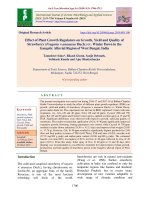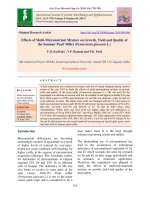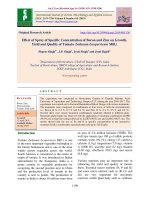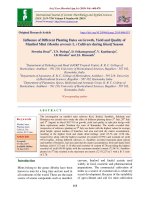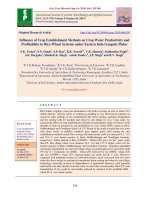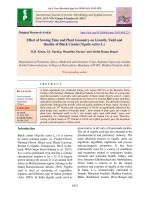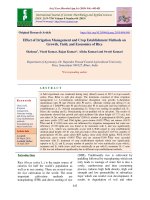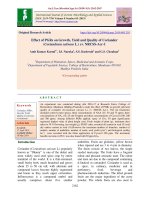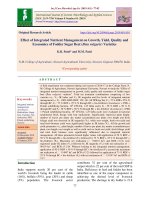Effect of irrigation management and crop establishment methods on growth, yield, and economics of rice
Bạn đang xem bản rút gọn của tài liệu. Xem và tải ngay bản đầy đủ của tài liệu tại đây (186.4 KB, 9 trang )
Int.J.Curr.Microbiol.App.Sci (2019) 8(4): 443-451
International Journal of Current Microbiology and Applied Sciences
ISSN: 2319-7706 Volume 8 Number 04 (2019)
Journal homepage:
Original Research Article
/>
Effect of Irrigation Management and Crop Establishment Methods on
Growth, Yield, and Economics of Rice
Shabana1, Vinod Kumar, Rajan Kumar*, Alisha Kumari and Sweeti Kumari
Department of Agronomy, Dr. Rajendra Prasad Central Agricultural University,
Pusa, Samastipur 848125, Bihar, India
*Corresponding author
ABSTRACT
Keywords
Grain yield,
Irrigation
management,
Alternate wetting
and drying method,
Crop establishment
methods,
Transplanting and
direct seeded rice
Article Info
Accepted:
04 March 2019
Available Online:
10 April 2019
A field experiment was conducted during rainy (kharif) season of 2017 at crop research
centre, Pusa, Bihar in split plot design. The treatments consisted of three irrigation
management i.e. I1-Continuous submergence throughout crop growth, I2-Saturation
maintenance upto PI and (5±2cm) after PI and I 3- Alternate wetting and drying (5 cm
irrigation at 3 DADPW) upto PI and (5±2cm) after PI in main plot and four methods of
establishment i.e. E1- Normal transplanting, E2- Direct wet seeding on puddled soil, E3Direct dry seeding and E4- Broadcasting on un-puddled soil in sub plots. The results of
experiments showed that growth and yield attributes like plant height (117.71 cm), leaf
area index (4.26), number of panicles/m2 (209.61), number of grains/panicle (88.04), grain
and straw yields (3722 and 5366 kg/ha), gross returns (84513 /ha), net returns (41435
/ha) and B: C (0.98) ratio were not influenced by irrigation management but water use
efficiency (37.90 kg/ha-cm) was found to be maximum with I3 and was significantly
superior to I1, which was statistically at par with I2.With regard to crop establishment
methods plant height (127.81 cm), leaf area index (4.64), panicles/m2 (219.12), number of
grains/panicle (91.44), grain yield (4053 kg/ha), straw yield (5826 kg/ha), WUE (44.50
kg/ha-cm), gross returns (91955 /ha) and net returns(47190 /ha) were recorded
maximum with E1 treatment of crop establishment methods which was significantly
superior to E2, E3 and E4 except, number of panicles /m2 were statistically at par with E2
treatment and E3 while straw yield was statistically at par with E2 treatment. B: C ratio
(1.06) was not influenced significantly due to different crop establishment methods.
(DSR). Traditionally rice is cultivated by
puddling followed by transplanting which not
only leads to wastage of water but is also a
costly, cumbersome and time consuming
process, induces high bulk density, high soil
strength and low permeability in subsurface
layer which can restrict root development. It
results in degradation of soil and other
Introduction
Rice (Oryza sativa L.) is the major source of
calories for half the world’s population as
well as in our country. There are several ways
for rice cultivation in the world. The most
important
cultivation
methods
are
transplanting (TPR) and direct seeding of rice
443
Int.J.Curr.Microbiol.App.Sci (2019) 8(4): 443-451
resources (Pathak et al., 2011) and
subsequently poses difficulties in seed bed
preparation for succeeding crop. Production
by this method requires approximately 3000
to 5000 litre of water to produce 1 kg of rice.
The increase in water scarcity and declining
rate of per capita fresh water availability
along with increasing demand of food has
made the present researcher to look for
alternate options which increase the water use
efficiency (WUE) along with saving of water.
Under such situation, DSR is a major
opportunity to change production practices to
attain optimal plant density and high water
productivity in water scarce areas. DSR is the
method of sowing seeds directly in the field.
There are three principal methods of DSR:
dry seeding (sowing dry seeds into dry soil),
wet seeding (sowing pre-germinated seeds on
wet puddled soils) and water seeding (seeds
sown into standing water). In addition to
higher economic returns, DSR crops are faster
and easier to plant, less labour intensive and
consume less water (Bhushan et al., 2007). In
non-puddled condition, eliminates the needs
of raising, maintaining and subsequent
transplanting of seedling. Besides early
maturity of crop, it allows timely sowing of
subsequent crop too. Also there is urgent need
to develop-irrigation water saving techniques
as well as proper irrigation schedule that
requires less irrigation input than the
traditional method, which also increase
production and productivity of rice crop.
Alternate wetting and drying (AWD)
irrigation is water saving technique in rice
production and is an important adaptation
strategy under climate change where water
scarcity may become more prevalent. Under
AWD, fields are subjected to intermittent
flooding (alternate cycles of saturated and
unsaturated conditions) where irrigation is
interrupted and water is allowed to subside
until the soil reaches a certain moisture level,
after which the field is again flooded.
Keeping in view of the above mentioned
prospects, the present investigation entitled
“Effect of irrigation management and crop
establishment methods on performance of
rice” has been conducted to assess the
performance of irrigation management and
crop establishment methods on growth and
yield of rice with higher WUE.
Materials and Methods
A field experiment was conducted during
kharif season of 2017 in split plot design with
three replications at Crop Research Centre,
Dr. Rajendra Prasad Central Agricultural
University, Pusa, Bihar, situated in
Samastipur district of North Bihar on the
Southern and Western bank of the river Burhi
Gandak at 25° 59' North latitude and 85°48´
East longitude with an altitude of 52.92
meters above mean sea level. It has subtropical and sub humid monsoon climate. The
average rainfall of the area is 1276.1 mm out
of which nearly 1026.0 mm is received during
the monsoon between June and September.
The treatments consisted of three irrigation
management i.e. I1-Continuous submergence
throughout crop growth, I2-Saturation
maintenance upto PI and (5±2cm) after PI and
I3- Alternate wetting and drying (5 cm
irrigation at 3 DADPW) upto PI and (5±2cm)
after PI in main plot treatments and four
methods of establishment i.e. E1- Normal
transplanting, E2- Direct wet seeding on
puddled soil, E3- Direct dry seeding and E4Broadcasting on un-puddled soil in sub plots.
The test cultivar was Abhishek.
The soil of experimental plot was sandy loam
in texture, alkaline in reaction (pH-8.5), low
in available N 154 kg/ha (Alkaline
permanganate method, Subbiah and Asija,
1956), P2O5 19.21 kg/ha (Olsen’s method,
Olsen et al., 1954) and K2O 121.00 kg/ha
(Flame photometer method, Jackson, 1967).
The crop was fertilized with 120:60:40:25
kg/ha N-P2O5-K2O-ZnSO4. Application of half
444
Int.J.Curr.Microbiol.App.Sci (2019) 8(4): 443-451
(50%) dose of nitrogen and total phosphorus
and potash and ZnSO4 were applied as basal
and remaining dose of nitrogen in two equal
splits (25% N at active tillering and 25% N at
panicle initiation stage).irrigation was applied
as per treatments. The amount of irrigation
applied was measured through Parshall flume.
The total input of water was the sum of
irrigation water and effective rainfall occurred
during the crop growing period. WUE is the
expression of the marketable product (grain)
obtained by per unit of water applied to the
crop. It can be determined with the help of the
following formula:
Water
use
efficiency
(kg/ha-cm)
Plant height
Plant height at harvest showed non-significant
difference with continuous submergence
throughout
crop
growth,
Saturation
maintenance upto PI and (5±2cm) after PI and
Alternate wetting and drying (5 cm irrigation
at 3 DADPW) upto PI and (5±2 cm) after PI.
It was due to adequate supply of water
maintained good establishment of root and
various metabolic processes that performed
better nutrient mobilization at all the three
irrigation management treatments. It was in
conformity with the result of Kumar et al.,
(2015). The maximum plant height (127. 81
cm) was recorded at harvest with normal
transplanting which was significantly superior
to direct wet seeding on puddled soil direct
dry seeding and broadcasting on un-puddled
soil. This might be due to plants were specific
distance in normal transplanting and the
competition between the plants were
minimum and deep penetration of roots
resulting in efficient use of nutrient uptake
and flooding providing good condition for
germination as well as for growth.
=
No incidence of diseases and pests occurred
during the crop season. However, Follidol
dust was applied before flowering to prevent
rice gundhi bug attack. The crop was
harvested when the leaves turned into yellow
to brown. The crop was harvested in morning
hours when there was enough overnight dew
to avoid the loss of grain shattering.
Harvesting was done manually with the help
of sickles. Before harvesting sample plants
were taken separately from 1 m2 and tagged
for postharvest studies.
Leaf area index
A critical examination of the data revealed
that the LAI did not vary significantly due to
different irrigation management practices.
This was due to adequate supply of moisture
which favored more number of large sizes
leaves at all the irrigation management
treatments. Similar result was also noticed by
Kumar et al., (2015). Different crop
establishment
methods
significantly
influenced LAI. The maximum LAI (4.64)
was observed at 90 DAS with normal
transplanting which was significantly superior
to direct wet seeding on puddled soil, direct
dry seeding and broadcasting on un-puddled
soil. This might be due to the facts that plants
were at specific distance in normal
transplanting and the competition between the
To eliminate the border effect, two rows from
all the four sides of the plot harvested
separately as border rows. Threshing and
winnowing of grains were done manually and
yield of sun dried grains were recorded
approximately at 14 per cent moisture.
Results and Discussion
Growth and yield attributing parameters
Growth and yield attributing parameters vary
non-significantly under various moisture
regimes
and
significantly
in
Crop
establishment method as shown in Table 1.
445
Int.J.Curr.Microbiol.App.Sci (2019) 8(4): 443-451
plants were minimum thus, crop enjoyed
favourable conditions with respect to light,
space and nutrients etc. Similar view was
expressed by Sharma et al., (2016).
(91.44/panicle) was observed with normal
transplanting which was significantly superior
to rest of the treatments. This might be due to
fertility of spikelets and development of
grains depend on environmental factors such
as nutrient, moisture and light, wider spacing
in normal transplanting possibly facilitated to
supply the more food materials, moisture and
light for the plant and ultimately developed
panicle length and grains/panicle. This result
was in close conformity to Sahu et al., (2015).
Number of panicles/m2
Irrigation management did not exert
significant influence on number of
panicles/m2 viz., continuous submergence
throughout
crop
growth,
Saturation
maintenance upto PI and (5±2cm) after PIand
alternate wetting and drying (5 cm irrigation
at 3 DADPW) upto PI and (5±2 cm) after PI.
These results were supported by Kadiyala
et al., (2012) and Kumar et al., (2015). In sub
plot treatments, Crop establishment methods
caused a significant variation on number of
panicles/m2.
The
highest
panicles/m2
2
(219.12/m ) was observed with normal
transplanting, which was statistically at par
with direct wet seeding on puddled soil, direct
dry seeding and significantly superior to
broadcasting on un-puddled soil. This might
be due to unavailability of proper plant
spacing in case of broadcasting on un-puddled
soil. This result was in close conformity to
Sahu et al., (2015).
Yield, Water use efficiency, Economics
Yield, Economics vary non significantly and
Water use efficiency vary significantly under
different moisture regimes while in Crop
establishment method all vary significantly
except B: C ratio as shown in Table 2.
Grain yield
Different irrigation managements did not
influence significantly the grain yield of rice.
Grain yield obtained with continuous
submergence throughout crop growth
recorded maximum value (37.22 q/ha) which
was closely followed by saturation
maintenance upto PI and (5±2cm) after PI and
alternate wetting and drying (5cm irrigation at
3 DADPW) upto PI and (5±2 cm) after PI.
This might be due to the grain yield of a crop
is the combined effect of various growth and
development parameters. In the present
investigation, almost all the growth and
development characters seemed to be unaffected by different irrigation management
treatments. These finding were collaborated
with the results of Dhar et al., (2008), Kumar
et al., (2015) and Sathish et al.,
(2017).Different crop establishment methods
exerted a significant effect on grain yield. The
maximum grain yield (40.53 q/ha) was
recorded with normal transplanting, which
was significantly superior to direct wet
seeding on puddled soil, direct dry seeding
Number of grains/ panicle
Number of grains/panicle depends on the
efficient translocation of photosynthates from
source to sink. Higher the translocation of
photosynthates higher will be the number of
grains per panicle. The effect of irrigation
management on number of grains/panicle was
found to be non-significant. This might be
due to efficient translocation through
continuous supply of water in all the irrigation
management treatments. The results are in
close conformity to those given by
Ramakrishna et al., (2007). While in sub plot
treatments
regarding
different
crop
establishment methods there was significant
effect.
The
highest
grains/panicle
446
Int.J.Curr.Microbiol.App.Sci (2019) 8(4): 443-451
and broadcasting on un-puddled soil because
the planting distance ensure air circulation,
water and light which are basic factors
necessary for photosynthesis. Further proper
spacing increases tillers and grain yield.
Similar results were obtained by Anbumani et
al., (2004) and Sahu et al., (2015).
drying (5 cm irrigation at 3 DADPW) upto PI
and (5±2cm) after PI and saturation
maintenance upto PI and (5±2cm) after PI
caused higher water use efficiency in
comparison to continuous water stagnant
treatment. This finding was confirmed by
Fonteh et al., (2013). The water use efficiency
with regard to different levels of crop
establishment methods was found to be
significant. The maximum water use
efficiency was recorded with normal
transplanting (44.50 kg/ha-cm) which was
significantly superior to direct wet seeding on
puddled soil, direct dry seeding and
broadcasting on un-puddled soil. This might
be due to the reason that WUE is directly
proportional to economic yield and due to
higher yield in normal transplanting.
Straw yield
Straw yield of rice was not affected
significantly by irrigation management. This
was due to non-significant effect increase in
plant height, LAI and number of tillers/m2.
Similar finding were reported by Kumar et
al., (2015). Analyzed mean data on straw
yield was significantly affected by crop
establishment methods. Higher straw yield
(58.26 q/ha) was associated with normal
transplanting which was statistically at par
with direct wet seeding on puddled soil and
significantly superior to direct dry seeding
and broadcasting on un-puddled soil due to
greater dry matter production per unit area,
caused by better nutrient absorption from the
soil, and the increased rate of metabolic
processes, rate of light absorption and
photosynthetic activity as well as more
number of leaves under normal transplanting.
Parameshwari and Srinivas (2014) also
reported the similar result.
Economics
Gross returns are the directive of total
biological (grain + straw) yield of any crop. In
case of irrigation management; it did not
significantly influence gross returns of rice. In
case of crop establishment methods,
maximum gross returns was recorded with
normal transplanting (91955 /ha) which was
significantly superior to direct wet seeding on
puddled soil, direct dry seeding and
broadcasting on un-puddled soil. This is due
to higher grain and straw yield obtained from
normal transplanting. Similar trend was
observed by Sanjay et al., (2006), Jnanesha
and Ashish (2017) and Kumar and Batra
(2017).
Water use efficiency
Water use efficiency was significantly
influenced due to different irrigation
managements. However, maximum value of
WUE was recorded with alternate wetting and
drying (5 cm irrigation at 3 DADPW) upto PI
and (5±2 cm) after PI (37.90 kg/ha-cm) which
was statistically at par with saturation
maintenance upto PI and (5±2cm) after PI and
was significantly superior to continuous
submergence throughout crop growth. This
might be due to higher yield of grain with
lower water use at alternate wetting and
Net returns were not influenced significantly
by different irrigation managements. The
maximum net returns recorded with
continuous submergence throughout crop
growth due to higher gross returns followed
by alternate wetting and drying (5cm
irrigation at 3 DADPW) upto PI and (5±2cm)
after PI and saturation maintenance upto PI
and (5±2cm) after PI.
447
Int.J.Curr.Microbiol.App.Sci (2019) 8(4): 443-451
Table.1 Effect of moisture regimes and crop establishment methods on growth and yield attributing characters of rice
Treatments
Irrigation management
I1
I2
I3
SEm±
CD (P=0.05)
Crop establishment
method
E1
E2
E3
E4
SEm±
CD (P=0.05)
Plant height (cm)
at harvest
Leaf area index
90 DAS
Number of
panicles/m2
Number of grains/
Panicle
117.71
109.63
107.27
2.70
NS
4.26
3.95
3.85
0.09
NS
209.61
205.89
203.66
3.66
NS
88.04
83.31
82.18
1.94
NS
127.81
4.64
219.12
91.44
111.39
4.01
207.11
84.11
109.46
3.93
204.95
83.60
97.48
3.49
194.37
78.89
5.23
0.13
5.15
2.43
15.54
0.39
15.30
7.22
I1-Continuous submergence throughout crop growth , I2-Saturation maintenance upto PI and (5±2cm) after PI , I3 -Alternate wetting and drying (5
cm irrigation at 3 DADPW) upto PI and (5±2 cm) after PI , E1- Normal transplanting , E2- Direct wet seeding on puddled soil , E3- Direct dry
seeding , E4- Broadcasting on un-puddled soil
448
Int.J.Curr.Microbiol.App.Sci (2019) 8(4): 443-451
Table.2 Effect of moisture regimes and crop establishment methods on yield, Water use efficiency, and economics of rice
Treatments
Grain yield
(kg/ha)
Straw yield
(kg/ha)
Water use
efficiency
(kg/ha-cm)
Gross
returns
( /ha)
Net returns
( /ha)
B: C
ratio
3722
3453
3365
78
NS
5366
4997
4889
158
NS
32.26
35.03
37.90
0.89
3.51
84513
78512
76604
1995
NS
41435
38934
39027
1995
NS
0.96
0.98
1.04
0.05
NS
4053
3509
3438
3053
114
339
5826
5077
4989
4443
259
769
44.50
29.80
34.92
31.04
1.18
3.51
91955
79774
78233
69543
3051
9065
47190
37279
40938
33788
3051
9065
1.06
0.88
1.10
0.95
0.08
NS
Irrigation management
I1
I2
I3
SEm±
CD (P=0.05)
Crop establishment method
E1
E2
E3
E4
SEm±
CD (P=0.05)
I1-Continuous submergence throughout crop growth , I2-Saturation maintenance upto PI and (5±2cm) after PI , I3 -Alternate wetting and drying (5
cm irrigation at 3 DADPW) upto PI and (5±2 cm) after PI , E1- Normal transplanting , E2- Direct wet seeding on puddled soil , E3- Direct dry
seeding , E4- Broadcasting on un-puddled soil
449
Int.J.Curr.Microbiol.App.Sci (2019) 8(4): 443-451
Similar result was found by Balasubramanian
and Krishnarajan (2001). There was
significant influence of different crop
establishment methods on net returns. The
maximum net returns was recorded with
normal transplanting (47190 /ha) which was
significantly superior to direct wet seeding on
puddled soil and broadcasting on un-puddled
soil but was statistically at par with direct dry
seeding. This was due to maximum gross
returns and cost of cultivation. These finding
were in agreement with Sanjay et al., (2006).
Irrigation management did not significantly
influence the B: C ratio. The maximum B: C
ratio (1.04) was recorded with alternate
wetting and drying (5 cm irrigation at 3
DADPW) upto PI and (5±2 cm) after PI and
minimum with continuous submergence
throughout crop growth. This was due less
requirement of irrigation and hence less cost
of cultivation in case of alternate wetting and
drying condition and more in continuous
submergence condition. These finding were in
agreement with Nayak et al., (2016). In crop
establishment methods, different treatments of
it did not significantly influenced the B: C
ratio. The maximum B: C ratio was recorded
with direct dry seeding (1.10) and minimum
with direct wet seeding on puddled soil
(0.88).This might be due to saving in labour
and water resulted in decreasing in cost of
cultivation as well as increasing net returns in
DSR condition. This result is in accordance
with finding of Gangwar et al., (2008) and
Jnanesha and Ashish (2017).
direct seeded rice as influenced by
irrigation levels. Indian Journal of
Agricultural Research 35(3): 194-197.
Bhushan, L., Ladha, J.K., Gupta, R.K., Singh,
S., Tirol-Padre, A., Saharawat, Y.S.,
Gathala, M. and Pathak, H. 2007.
Saving of water and labor in a rice–
wheat system with no-tillage and direct
seeding
technologies. Agronomy
Journal 99(5): 1288-1296.
Dhar, R., Gupta, N. K. and Samanta, A. 2008.
Effect of irrigation scheduling on the
performance of kharif rice grown under
different
establishment
methods.
Journal of Research, SKUAST-J7(2):
277-280.
Fonteh, M.F., Tabi, F.O., Wariba, A.M. and
Zie, J. 2013. Effective water
management practices in irrigated rice
to ensure food security and mitigate
climate change in a tropical climate.
Agriculture and Biology Journal of
North America 4(3): 284-290.
Gangwar, K. S., Gill, M. S., Tomar, O. K. and
Pandey, D. K. 2008. Effect of crop
establishment methods on growth,
productivity and soil fertility of ricebased cropping system. Indian Journal
of Agronomy 53(2): 102-106.
Jackson, M. L. 1967. Soil Chemical Analysis,
Prentice Hall of India Pvt. Ltd., New
Delhi: 498.
Jnanesha, A. C. and Kumar, A. 2017. Effect
of crop establishment methods on
growth yield and water productivity of
rice.
International
Journal
on
Agricultural Sciences 8(1): 40 45.
Kadiyala, M. D. M., Mylavarapu, R.S., Li, Y.
C., Reddy, G. B. and Reddy, M. D.
2012. Impact of aerobic rice cultivation
on growth, yield and water productivity
of rice-maize rotation in semi-arid
tropics. Agronomy Journal 104(6):
1757-1765.
Kumar, R. and Batra, S.C. 2017. A
Comparative
Analysis
of
DSR
References
Anbumani, S., Chandrasekharan, B. and
Kuppuswamy, G. 2004. Evaluation of
establishment methods and NPK levels
in rice and their impact on succeeding
crops. Agricultural Science Digest
24(3): 190-193.
Balasubramanian, R. and Krishnarajan, J.
2001. Yield and correlation studies in
450
Int.J.Curr.Microbiol.App.Sci (2019) 8(4): 443-451
Technology Vs. Transplanted Method
in Haryana. Economic Affairs 62(1):
169-174.
Kumar, R., Das, S., Kumar, V., Dwivedi,
D.K. and Das, L. 2015. Studies on
irrigation and weed management for
enhancing rice yield and water
productivity under system of rice
intensification. The Bioscan 10(1): 417420.
Nayak, B.R., Pramanik, K., Khanda, C.M.,
Panigrahy,
N.,
Samant,
P.K.,
Mohapatra, S., Mohanty, A.K., Dash,
A.K., Panda, N. and Swain, S.K. 2016.
Response of aerobic rice (Oryza sativa
L.) to different irrigation regimes and
nitrogen levels in western odisha.
Indian Journal of Agronomy 61(3): 321325.
Olsen, S.R., Cole, C.U., Watanable, F.S. and
Dean, L.A. 1954. Estimation of
available phosphate in soils by
extraction with NaHCO3. USDA
Circular: 939.
Parameswari, Y.S. and Srinivas, A. 2014.
Influence of weed management
practices on nutrient uptake and
productivity of rice under different
methods of crop establishment. Journal
of Rice Research 7: (1&2).
Pathak, H., Tewari, A.N., Sankhyan, S.,
Dubey, D.S., Mina, U., Singh, V.K.,
Jain, N. and Bhatia, A. 2011. Directseeded rice: Potential, performance and
problems- A review. Current Advances
in Agricultural Sciences 3(2): 77-88.
Ramakrishna, Y., Singh, S. and Parihar, S. S.
2007. Influence of irrigation regime and
nitrogen management on productivity,
nitrogen uptake and water use by rice
(Oryza sativa). Indian Journal of
Agronomy 52: 102-106.
Sahu, R., Singh, M.K. and Yadav, L. 2015.
Yield and economics as influenced by
nitrogen scheduling, weed management
and rice establishment methods in
transplanted rice (Oryza sativa). Indian
Journal of Agronomy 60(2): 261-266.
Sanjay, M. T., Prabhakara, T. K. and
Nanjappa, H. V. 2006. Soil test crop
response approach in rice (Oryza sativa
L.) under different methods of crop
establishment. Crop Research 31: 346349.
Sathish, A., Kumar, K. A., Reddy, P. R. R.,
and Devi, M. U. 2017. Effect of
different crop establishment methods
and irrigation regimes on rice (Oryza
sativa L.) Yield and Water Use
Efficiency. International journal of
Current Microbiology and Applied
Sciences 6(9): 90-95.
Sharma, V., Bali, A.S. and Kachroo, D. 2016.
Effect of different establishment
methods and sowing schedules on
growth and yield of hybrid rice (Oryza
sativa) and their after effects on
succeeding wheat (Triticum aestivum)
in rice –wheat cropping system.
Economic Affairs 61(3): 487-493.
Subbiah, B.V. and Asija, G. L. 1956. A rapid
procedure for assessment of available
nitrogen in rice soil. Current Science
31: 196.
How to cite this article:
Shabana, Vinod Kumar, Rajan Kumar, Alisha Kumari and Sweeti Kumari. 2019. Effect of
Irrigation Management and Crop Establishment Methods on Growth, Yield, and Economics of
Rice. Int.J.Curr.Microbiol.App.Sci. 8(04): 443-451.
doi: />
451
